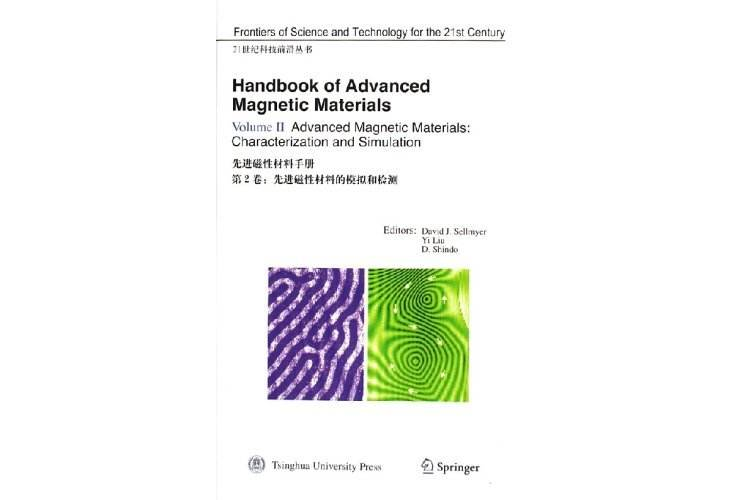《先進磁性材料的模擬和檢測》是2006年出版的圖書,作者是劉義。
基本介紹
- 書名:先進磁性材料的模擬和檢測
- 作者:劉義
- 出版社:清華大學出版社
- 出版時間:2006年
- 定價:139 元
- 裝幀:精裝
- ISBN:9787302087014
- 印次:1-2
- 印刷時間:2006-8-1
圖書簡介,目錄,
圖書簡介
本書的目的是對磁性材料研究的新近進展提供一種全面的理解。本書共分四卷,每一卷集中論述一個具體的研究領域。每一章首先對該章的基本概念和重要觀念進行闡述,然後從實驗和理論方面進行詳細地說明,最後介紹該領域的發展前景以及新的思想。書中提供了詳盡的參考文獻,可供研究人員參考。
原子磁矩和巡迴磁模型的建立墊定了我們對磁性的理解。記算是有效的方法來驗正理論及予測新性能。在此過程中建立模型和其邊界條件需要對材料的幾何形狀,結構和性能進行準確的測量。第2卷收集總結磁性理論、 模擬、結構和性能的測量的最新成果。
本書的讀者對象為研究生和相關專業的研究人員。
目錄
1.1Introduction1
1.2MagneticForceMicroscopy2
1.2.1BasicOperatingPrinciplesofMFM2
1.2.2ForceGradientDetection2
1.2.3SensitivityandResolution3
1.2.4Tip\|SampleInteraction4
1.2.5ForceSensor7
1.3DevelopmentofAdvancedMFMTips8
1.3.1HighCoercivityCoPtMFMTips8
1.3.2SuperparamagneticandLowStrayMagneticField
MFMTips13
1.3.3Electron\|Beam\|Induced\|Deposited
(EBID)MFMTips15
1.3.4Point\|DipoleMFMTips17
1.3.5FocusedIonBeamMillingMFMTips20
References22
2LorentzMicroscopyandHolographyCharacterizationofMagnetic
Materials24
2.1Introduction24
2.2Instrumentation25
2.3AnalyticalElectronMicroscopyforStructure
Characterization29
2.3.1OutlineofCurrentAnalyticalElectron
Microscopy29
2.3.2ThicknessMeasurementbyEELS31
2.3.3ElementalMappingwithEDS33
2.4LorentzMicroscopyonMagneticDomainStructure35
2.4.1PrinciplesofLorentzMicroscopy35
2.4.2LorentzMicroscopyUsingConventionalTransmission
ElectronMicroscopes36
2.4.3LorentzMicroscopyUsingScanningTransmission
ElectronMicroscopes44
2.5PrinciplesandApplicationofElectronHolography46
2.5.1PrinciplesofElectronHolography46
2.5.2PracticeofElectronHolography51
2.5.3ApplicationofElectronHolography52
2.6ConcludingRemarks63
References63
3CharacterizationofMagneticMaterialsbyMeansofNeutron
Scattering66
3.1Introduction66
3.1.1CrossSectionFormalism69
3.1.2PolarizedNeutronBeamInstrumentation71
3.1.3ThePolarizationoftheScatteredBeam77
3.2ElasticMagneticScattering80
3.2.1SmallAngleScattering80
3.2.2NeutronDiffraction84
3.2.3ReflectionofNeutronsfromMagneticSurfacesand
Interfaces90
3.3InelasticMagneticScattering97
3.3.1StudiesofElementaryExcitationsbyTripleaxis
Spectroscopy97
3.3.2DetectionofSlowMotionsbyNeutronSpinEcho101
3.4Summaries107
References108
4AdvancedTransmissionElectronMicroscopyofNanostructured
MagneticMaterials113
4.1Introduction113
4.2SpecimenPreparation114
4.2.1BulkSamples114
4.2.2MagneticThinFilms114
4.2.3MagneticNanowires118
4.2.4MagneticPowders119
4.2.5SpecialTechniques120
4.3ElectronDiffraction121
4.3.1SADPatternandtheRingPattern121
4.3.2ConvergentBeamElectronDiffraction122
4.3.3Nanodiffraction124
4.4HighResolutionandSuperResolutionTEM129
4.4.1AnImageProcessingModel130
4.4.2ProcedureforImageReconstruction135
4.4.3TestoftheImageProcessingModel135
4.5SelectedReflectionImaging138
4.5.1OriginationoftheTechnique138
4.5.2ExperimentalMethodinConventionalTEM139
4.5.3ApplicationofSRI140
4.5.4ExperimentalSetUpinaSTEM142
4.6STEMandZContrastImaging143
4.7ElectronEnergyLossSpectroscopy145
4.8ConcludingRemarks148
References148
5MssbauerSpectroscopyCharacterizationofSoftMagnetic
NanocrystallineAlloys151
5.1Introduction151
5.2MssbauerSpectroscopy155
5.2.1PrinciplesoftheMssbauerEffect155
5.2.2HyperfineInteractions164
5.2.3TherfMssbauerTechnique168
5.3Experiment171
5.3.1FormationoftheCrystallineNanostructurein
AmorphousMatrix171
5.3.2PrimaryCharacterizationofThermalStabilityofAmorphous
Precursor—FormationofNanostructure173
5.4MssbauerStudyoftheStructureandMagnetismofFINEMET
Alloys178
5.5MssbauerStudyoftheStructureandMagnetismof
NANOPERMAlloys188
5.5.1ConventionalMssbauerStudies191
5.5.2TherfMssbauerStudies212
5.6SurfaceandBulkNanocrystallizationofAmorphousFeCuNbSiB
andFeMBCuAlloys\|theCEMSStudy232
5.7ShortRangeOrderinAmorphousPrecursors—the
rfMssbauerStudy244
5.8DeterminationoftheGrainSizebyXRDandSAXS
Techniques\|CorrelationwiththeMssbauerResults250
References260
6AtomProbeCharacterizationofMicrostructuresofNanocrystalline
andNanocompositeMagneticMaterials266
6.1Introduction266
6.2TheAtomProbeTechnique267
6.3MicrostructuralEvolutioninNanocrystallineSoftMagnetic
Materials271
6.3.1FINEMET(FeSiBNbCu)271
6.3.2NANOPERM(FeZrB(Cu))279
6.3.3HITPERM((Fe,Co)ZrBCu)287
6.4MicrostructuralEvolutioninNanocompositeMagnets289
6.4.1Fe3B/Nd2Fe14BSystem290
6.4.2αFe/Nd2Fe14BSystem295
6.4.3AmorphousRemainingαFe/Nd2Fe14B
Nanocomposite299
6.5RolesofMicroalloyedElementsinNanocrystallization301
6.6EffectofHeatingRatesonNanocrystallineMicrostructure
Evolution304
6.7Summary306
References306
7ItinerantElectronMetamagnetism310
7.1Introduction310
7.2TheoreticalAspectsofItinerantElectronMetamagnetism311
7.2.1LandauExpansionCoefficientsandMagneticPhase
Diagram311
7.2.2ParamagneticSusceptibilityMaximuminthe
TemperatureDependence314
7.3ItinerantElectronMetamagnetismofLavesPhase
ExchangeEnhancedPauliParamagnets315
7.3.1MetamagneticTransitionintheGroundState315
7.3.2RelationshipBetweentheSusceptibilityMaximum
andtheTransitionField317
7.3.3MetamagneticTransitionatFiniteTemperatures320
7.4CorrelationBetweentheMagnetovolumeEffects
andMetamagneticTransition321
7.4.1ConcentrationDependenceoftheCurieTemperature
andSpontaneousMagnetization321
7.4.2PressureEffectsontheCurieTemperatureand
SpontaneousMagnetization322
7.4.3ThermalExpansionAnomalyandSpinFluctuations327
7.5DeterminationoftheLandauCoefficients329
7.5.1PressureEffectontheCriticalFieldofthe
MetamagneticTransition329
7.5.2ComparisonBetweentheExperimentalandTheoretical
MagneticPhaseDiagrams333
7.6SuppressionofSpinFluctuationsinLavesphase
Metamagnets337
7.6.1ConcentrationDependenceoftheSpecificHeatCoefficient
ofLavesPhaseCompounds337
7.6.2LargeElectronicSpecificHeatCoefficientDuetoSpin
FluctuationsandItsSuppressionUnderHighFields338
7.7MetamagneticTransitionatFiniteTemperaturesofFerromagnetic
La(Fe1-xSix)13NaZn13typeCompounds340
7.7.1MagnetizationandMagneticPhaseDiagram340
7.7.2ThermalExpansionAnomaly346
7.7.3PressureEffectontheMetamagneticTransition347
7.7.4ControloftheMetamagneticTransitionbyHydrogen
Absorption350
7.8DrasticChangesinMagneticandElectricalPropertiesand
TheirPracticalApplications353
7.8.1IsotropicGiantVolumeMagnetostriction353
7.8.2GiantMagnetocaloricEffect358
7.8.3GiantMagnetoresistance365
7.9ConcludingRemarks366
References367
8ModelingofHysteresisinMagneticMaterials372
8.1Introduction372
8.2DevelopmentofModelTheoriesofHysteresis373
8.3MagnetismattheDiscreteLevelofIndividualAtomsandBeyond
totheContinuumLevel:LandauLifschitzGilbertModeland
Micromagnetics375
8.4MagnetismofDomainRotation:StonerWohlfarth378
8.5MagnetismattheLevelofDomainBoundaries:
Neel,GlobusGuyot,Bertotti382
8.6MagnetismattheMacroscopicScale:theIntegrationofSingle
DomainSwitchingProcessesandthePreisachModel386
8.7MagnetismattheMultidomainLevel:EnergyConsiderations
andtheJilesAthertonModel391
8.7.1DescriptionoftheAnhystereticMagnetization392
8.7.2ExtensiontoDescribeHysteresis393
8.7.3ExtensiontoDescribetheEffectsofStress
onMagnetization395
8.7.4ExtensiontoDescribetheEffectsofFrequencyon
Magnetization396
8.7.5Applications397
8.8Summary403
References404
9Coarse\|grainingandHierarchicalSimulationofMagneticMaterials:
theFastMultipoleMethod407
9.1Introduction407
9.2TheFastMultipoleMethod:SimplestImplementation408
9.3CartesianFormulationoftheFMM414
9.4HistoryoftheFMM416
9.5MicromagneticApplicationsoftheFMM417
References420
10NumericalSimulationofQuasistaticandDynamicRemagnetization
ProcesseswithSpecialApplicationstoThinFilmsand
Nanoparticles421
10.1BasicMicromagneticConceptsandMainEnergy
Contributions421
10.2DiscretizationMethods:SimplicityandSpeed
VersusExactShapeApproximation422
10.2.1Regular(TranslationallyInvariant)Grids423
10.2.2TetrahedronMesh424
10.3EvaluationofVariousEnergyContributions427
10.3.1AnisotropyEnergyinPolycrystallineSamples428
10.3.2ExchangeEnergy:Node\|supportedDiscretization,
Heisenberg\|LikeFormandAngle\|based
Interpolation429
10.3.3StrayFieldEvaluationonRegularGrids434
10.4EnergyMinimizationMethods443
10.4.1StandardMinimizationTechnique:Conjugate
Gradients444
10.4.2EquationofMotionTechniquesandSimple
RelaxationMethods447
10.4.3AdvancedRelaxationMethodsCombinedwiththe
ExtrapolationTechniques449
10.4.4AlignmentMethods451
10.5EquilibriumMagnetizationStructuresandQuasistatic
RemagnetizationProcesses454
10.5.1NanosizedMagneticElements454
10.5.2ExtendedThinFilmsandPatternedStructures459
10.5.3QuasistaticRemagnetizationinNanocomposites:
IndividualParticleSwitchingandCooperative
RemagnetizationProcesses463
10.6EquilibriumandNon\|EquilibriumThermodynamics:Langevin
Dynamics,MonteCarloMethodandPathIntegrals469
10.6.1FastRemagnetizationProcesses:Langevin
Dynamicsvs.MonteCarloMethod469
10.6.2SlowRemagnetizationDynamics489
References503
11PreisachModelandSimulationofRelaxationKinetics508
11.1Introduction508
11.2TheResponseOperator509
11.3ThePreisachModel510
11.4EnsemblesofSystemsinRandomPotential518
11.5RepresentabilityoftheEnsembleEvolutionbythePM520
11.6Connectionofthe“Classical”IrreversibilityParameters
withthePM523
11.7RepresentationsofSomeEnsemblesbythePM525
11.7.1CampbellRandomPotentialandStabilizationof
DomainWalls525
11.7.2PeriodicPotentialswithRandomPhase530
11.8UncertaintyinPredictionofRelaxationKinetics
BasedonthePM535
11.9Summary539
References540
12AntiferromagnetismofMnAlloys541
12.1Introduction541
12.2TheoryofItinerantElectronMagnetismwiththe
HubbardModel542
12.2.1ModelfortheItinerantElectronSystems542
12.2.2Path\|IntegralApproachfortheItinerant\|Electron
Magnetism542
12.2.3SaddlePoint(MolecularField)Approximation544
12.2.4RotationoftheLocalSpinAxesintheComplex
MagneticStructures545
12.2.5MagneticExcitationEnergyandtheExchange
Constant547
12.3FirstPrinciplesApproachfortheMagneticStructuresof
TransitionMetalSystems550
12.3.1Tight\|binding(TB)\|LMTOMethodforComplex
MagneticStructures550
12.3.2CoherentPotentialApproximation(CPA)for
DisorderedAlloys552
12.3.3EffectiveExchangeConstant553
12.4ElectronicandMagneticStructuresofγ\|Mnand
Mnalloys554
12.4.1γ\|Mn554
12.4.2FeMnDisorderedAlloy559
12.4.3L10\|TypeMnPt,MnNiandMnPdAlloys564
12.4.4L12\|Typeandγ\|PhaseMn3IrAlloys572
12.5ExperimentalObservationsofAntiferromagnetism
ofMnAlloys578
12.5.1ConcentrationDependenceoftheNéelTemperature
ofL12\|type(≡γ′\|Phase)MnOrdered
AlloySystems578
12.5.2ConcentrationDependenceoftheNéelTemperature
ofγ\|phaseMnDisorderedAlloySystems581
12.5.3LatticeDistortionsandSpinStructuresof
γ\|phaseMnDisorderedAlloys582
12.5.4ConcentrationDependenceoftheNéelTemperature
ofL10(≡CuAu\|I)\|typeAlloySystems586
12.5.5Low\|temperatureSpecificHeatandTemperature
DependenceofElectricalResistivity587
12.6AntiferromagneticPropertiesRelatedtoMagnetic
Devices589
12.6.1MagnetovolumeEffectsandThermalStrains590
12.6.2BlockingTemperatureandMagneticDomainsin
Antiferromanets593
12.6.3FrustrationofAntiferromagneticSpinStructures
andExchangeBiasField594
12.7ConcludingRemarks597
References597

